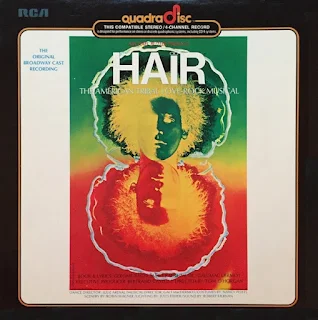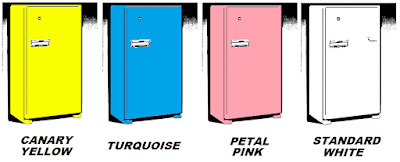The first American stereophonic discs were released by Audio Fidelity Records, in March, 1958. The four 33 & a third titles were..
The Stereo-Pak made the first practical car audio possible. The system used a continuous loop of tape that was enclosed in a plastic cartridge. The 4 tape tracks were played two at a time, with a tape head switching positions once. While playing, the tape head did not change programs automatically. This would have to be done manually (the 8-track format featured an automatic program-changing mechanism).
Image from https://www.discogs.com
In June 1969, recorded music advanced to four channels -or quadraphonic sound- with the first 4-channel, prerecorded open reel tapes. These were followed, in November 1970, by RCA's introduction of the quadraphonic 8-track -or Q-8- cartridge tape.
Another obsolete vestige of America's mid-century, the Quad-8 cartridge. These made their first appearance in late 1970. Unlike Stereo-8 format tapes, that had arrived on the scene 5 years earlier, Quad-8s only switched tracks once..instead of three times. Oh yes, the two formats were not compatible. If you played a Quad-8 on a Stereo-8 system, you would hear only half of the song at one time.
Image from RCA Records-http://www.8-track-shack.com
In 1971, the first matrix quadraphonic LPs appeared, utilizing the ABC-Sansui QS system. Columbia-Sony countered with SQ matrix LPs in 1972. These were followed by RCA-JVC's discrete quad format, known as CD-4 or Quadradisc. Unlike the Quad-8 tape format, all three Quadraphonic LP formats were stereo-compatible.
The Quad Revolution moved ever onward with the release of the first six 4-channel LP's, in March 1971. These Command Quadraphonic discs were produced by ABC Records. To hear a QS disc reproduced properly, one would have to own a Sansui system, with a QS Vario Matrix Decoder. Back in the day, Quadraphonic record albums could have been purchased at just about any Camelot Music, Record Bar or Sam Goody shopping mall store.
Image and logo from ABC Records and Sansui Electronics (see media fair use rationale at end of article)
The first Columbia-Sony SQ LPs were released in April 1972. Similar to the ABC-Sansui system, SQ Full Logic created the illusion of four separate sound tracks by "encoding" each of the two rear channels into the two in front. It worked pretty well. In fact, SQ quad recordings -such as Santana's "Abraxas" album, Pink Floyd's "Atom Heart Mother" album (a British import) and Edgar Winter's "Frankenstein" song- demonstrated some neat, moving-around-the-room effects.
In February 1973, JVC-RCA's CD-4 or Quadradisc LP format made its debut. CD-4 used an ultrasonic "carrier wave," which instructed a CD-4 Demodulator to divide the audio into four separate sound channels.
To convert from stereo to quad, one would need to either scrap everything and buy an entirely new sound system or else acquire an additional stereo amp, two more speakers and the appropriate decoder(s). For CD-4, one would also have to have the CD-4 demodulator, a new turntable and phono cartridge that could accommodate the additional frequency range of the carrier wave.
The sonic separation of CD-4 LPs was superior to that of the two matrix systems...however, there was also a great deal of distortion with the CD-4 system that was not present when playing QS or SQ matrix quadraphonic LPs.
The three competing -and totally non-compatible- systems vied for prominence through the remainder of the 1970s, with none emerging victorious. Quad sound was gone and nearly forgotten by the advent of the digital compact disc, in 1983.
A conventional electric or gas range was essentially the same in 1947 and 2017. However, the microwave oven went through a great deal of changes before becoming a common fixture in the American home. The Raytheon Company introduced its first "Radarange" in 1947. It was gigantic, weighing 750 pounds and costing $5,000. This converts to over $68,000 in today's buying power!
The first Radaranges were a commercial-grade product, sold only to restaurants and other food vendors. The first microwaves sold to the general public came out in early 1968. At this time, an Amana Radarange sold for $495 (or $4,400 in today's buying power). As they became more commonplace, microwave ovens became less expensive. They were a standard fixture in the American home by the mid-1980s.
The typical electric refrigerator was quite a bit different in the mid-century than it is today. Although "frost-free" models became available in 1950, they were something of a novelty for years thereafter.Back in the day, mom would have to spend hours "defrosting" the conventional, non-frost-free 'fridge. All food in the freezer compartment would have to be removed. The task of getting rid of several inches of ice that had accumulated on the inside walls of the freezer was a tedious, messy chore.
This was done (carefully) with an ice pick or (haphazardly) with several splashes of warm water onto the affected parts. Of course, the thawing, dripping mess would need to be mopped up several times during the defrosting ordeal...which had to be done every couple of months.
A circa-1953 refrigerator. Its tiny freezer compartment might accommodate a box of ice cream, a few "tv dinners" and a couple ice cube trays...if it was not frozen over due to not having been "defrosted" in the recent past. Refrigerators of this era define the term "clunky." Walls, using substandard insulating materials of the time, were incredibly thick, taking up much interior space. Doors opened and shut tightly with latches.
By 1960, more modern refrigerators were on the market. Technology had provided more efficient insulating materials, making slimmer walls -and additional interior space- possible. The latch-operated doors of yesteryear had been replaced with better closing apparatus.






























